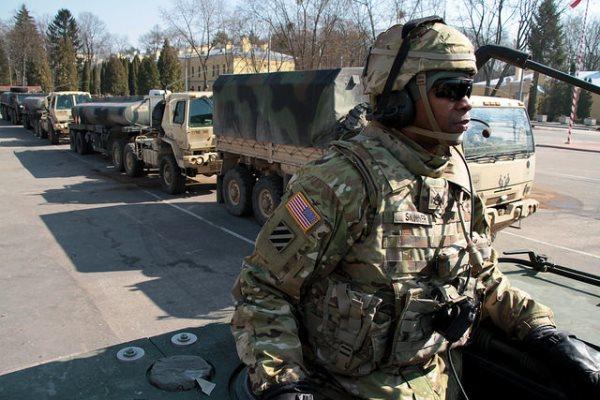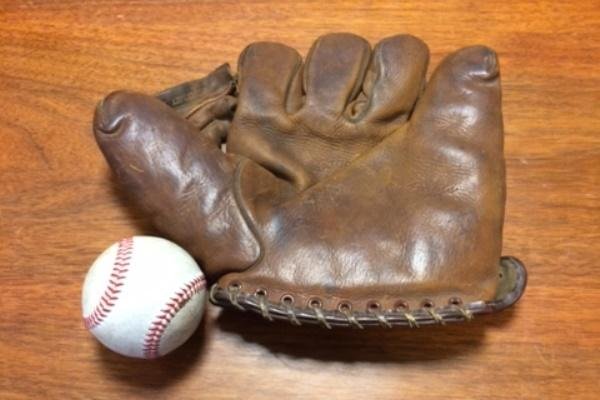As U.S. Stryker fighting vehicles rolled into Prague late last month, the soldiers of the 2nd Cavalry Regiment were approached by a 78-year-old man carrying an old fielder's baseball glove that was emblematic of the U.S. Army's history in Europe since World War II.
The Czech man told Col. John Meyer's troops that the glove was given to him as an eight-year-old boy by the GIs who came to liberate his town from the Nazis 70 years ago.
"He just came up and presented it, said he'd been waiting 70 years to thank the U.S. soldiers and this was his way of doing it," said Meyer, the 2nd Cavalry's commander.
The troops tried to give the glove back to the man - they never did get his name - but he insisted that the U.S. Army should have it.
The old five-finger model with the pancaked pocket was the kind that had fathers and coaches of another era teaching their kids to catch with two hands, always. It will now go into the 2nd Cav's regimental museum in Vilseck, Germany, Meyer said.
The stop in Prague came towards the end of an 1,100-mile road march across Europe dubbed "Dragoon Ride" by more than 100 Army vehicles, including about 60 Strykers.
In the course of the trip from March 22-April 1, units from 3rd Squadron of the 2nd Cav in Estonia, Lithuania and Poland converged on their way back to their home base at Rose Barracks in Vilseck. The convoy was supported from the air by the Army's 12th Aviation Combat Brigade.
"It was an opportunity for us to show our readiness and to assure our allies that we're credible allies," Meyer said by phone from Hohenfels, Germany.
Along the route that took them through six countries, the troops were met at each stop by supportive crowds who saw the Americans as safeguards against the increasing threats of Russian President Vladimir Putin.
Even on the move, "it seemed like there were people on every overpass," some of them waving U.S. flags, Meyer said.
The official Army line on Dragoon Ride was that it gave the 2nd Cav troops "an opportunity to test their unit maintenance and leadership capabilities while simultaneously providing a highly visible U.S. commitment to its NATO allies and demonstrating NATO's abilities to move military forces across freely across allied borders in close cooperation."
Lt. Gen. Ben Hodges, commander of U.S. Army Europe (USAEUR) explained that the Army was going through a complicated arrangement to put the vehicles on rail cars to bring them back to Vilseck, "so why don't we just have them drive back?"
In a phone interview, Hodges said that the idea for Dragoon Ride grew out of the NATO summit in Wales last summer in response to Putin's moves in Crimea and Ukraine.
The focus of the summit was on Article 5 of the NATO Treaty calling for a collective response to aggression against a member state. Hodges was looking for ways to give "assurance" to allies that Article 5 would be followed to the letter, and Dragoon Ride offered a method.
Hodges said he also had been impressed by Russians' ability to "move so many people, so far, so fast" in their so-called "snap" training exercises that menaced NATO's borders.
He wanted to show that the Americans could do the same while providing visibility to the people of Eastern Europe who were counting on the U.S. presence. At a few points, the convoy rolled close to Russian territory to let Russian citizens and their media have a look.
"It turned out to be far better than I could've imagined - to have all these towns and communities seeing these American soldiers moving through," Hodges said. "And what an adventure for these young leaders," Hodges said.
He reflected on the image of the old man in Prague bringing the baseball glove he had cherished all those years to a new generation of GIs.
"I like to think that's what the U.S. truly represents," Hodges said.Dragoon Ride was part of NATO's Atlantic Resolve training exercise that will include about 30 separate exercises this year at the battalion level and above from the Baltic to the Black Sea.
-- Richard Sisk can be reached at Richard.Sisk@military.com.





























